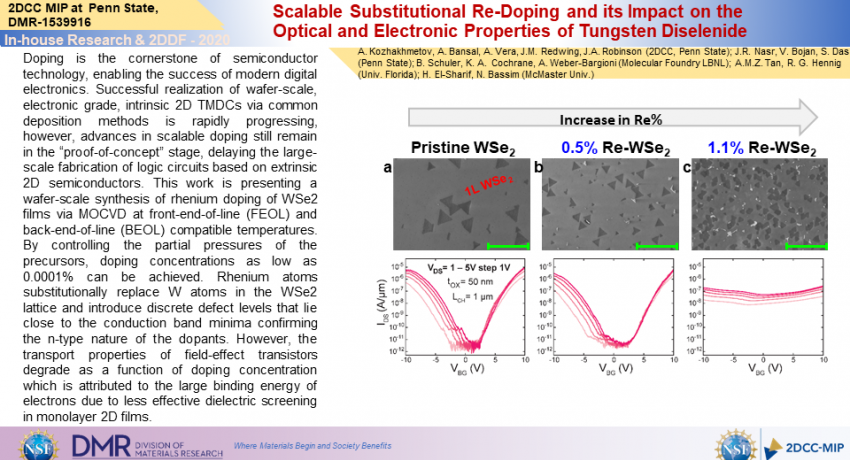What Has Been Achieved:
We have demonstrated scalable rhenium doping of front-end-of-line (FEOL) and back-end-of-line (BEOL) compatible WSe2 films with precisely controlled doping concentration down to 0.0001% on c-plane sapphire and SiO2/Si substrates.
Importance of the Achievement:
Reliable, controlled doping of 2D transition metal dichalcogenides will enable the realization of next-generation electronic, logic-memory, and magnetic devices based on these materials. However, to date, accurate control over dopant concentration and scalability of the process remains a challenge. In our study for the first time in the community we report scalable doping of 2D WSe2 films with the highest accuracy that will be indispensable in constructing low power, logic devices. In addition, we found that electrical activation of the introduced dopants is a strong function of the thickness of the films.
Unique Feature(s) of the MIP that Enabled this Achievement:
Scalable MOCVD synthesis of intrinsic and extrinsic WSe2.
Publication:
A. Kozhakhmetov, B. Schuler, A.M.Z. Tan, K.A. Cochrane, J.R. Nasr, H. El-Sherif, A. Bansal, A. Vera, V. Bojan, J.M. Redwing, N. Bassim, S. Das, R.G. Hennig, A. Weber-Bargioni, J.A. Robinson, Scalable Substitutional Re-doping and its Impact on Optical and Electronic Properties of Tungsten Diselenide, Adv. Mater. 2020, 32, 2005159. DOI: 10.1002/adma.202005159
Acknowledgements:
A.K. and J.A.R would like to acknowledge Intel through the Semiconductor Research Corporation Task 2746.001, the Penn State 2D Crystal Consortium (2DCC)-Materials Innovation Platform (2DCC-MIP) under NSF cooperative agreement DMR- 1539916, and NSF CAREER Award 1453924. Scanning probe measurements were performed at the Molecular Foundry supported by the Office of Science, Office of Basic Energy Sciences, of the U.S. Department of Energy under Contract No. DE-AC02-05CH11231. This work was supported as part of the Center for Novel Pathways to Quantum Coherence in Materials, an Energy Frontier Research Center funded by the US Department of Energy, Office of Science, Basic Energy Sciences. K.C. was supported by the University of California - National Lab Collaborative Research and Training (UC-NL CRT) program. A.W.-B. was supported by the U.S. Department of Energy Early Career Award. B.S. appreciates support from the Swiss National Science Foundation under project number P2SKP2 171770. A. M. Z. T. and R. G. H. were also funded by the NSF through the 2DCC-MIP under award DMR-1539916, and by additional awards DMR-1748464 and OAC-1740251. Computational resources were provided by the University of Florida Research Computing Center. A.B. and J.M.R. also would like to acknowledge the Penn State 2D Crystal Consortium (2DCC)-Materials Innovation Platform (2DCC-MIP) under NSF cooperative agreement DMR- 1539916.
Credits/Names: A. Kozhakhmetov, A. Bansal, A. Vera, J.M. Redwing, J.A. Robinson (2DCC, Penn State); J.R. Nasr, V. Bojan, S. Das (Penn State); B. Schuler, K. A. Cochrane, A. Weber-Bargioni (Molecular Foundry LBNL); A.M.Z. Tan, R. G. Hennig (Univ. Florida); H. El-Sharif, N. Bassim (McMaster Univ.)
Download PDF Version: 2DCC Highlights December 2020_ScalableSubstitutionalRe-DopingImpactOnOpticalElectronic PropertiesWSe2.pdf
Year of Research Highlight: 2020
Select a Highlight Type: In-House Research Highlight
